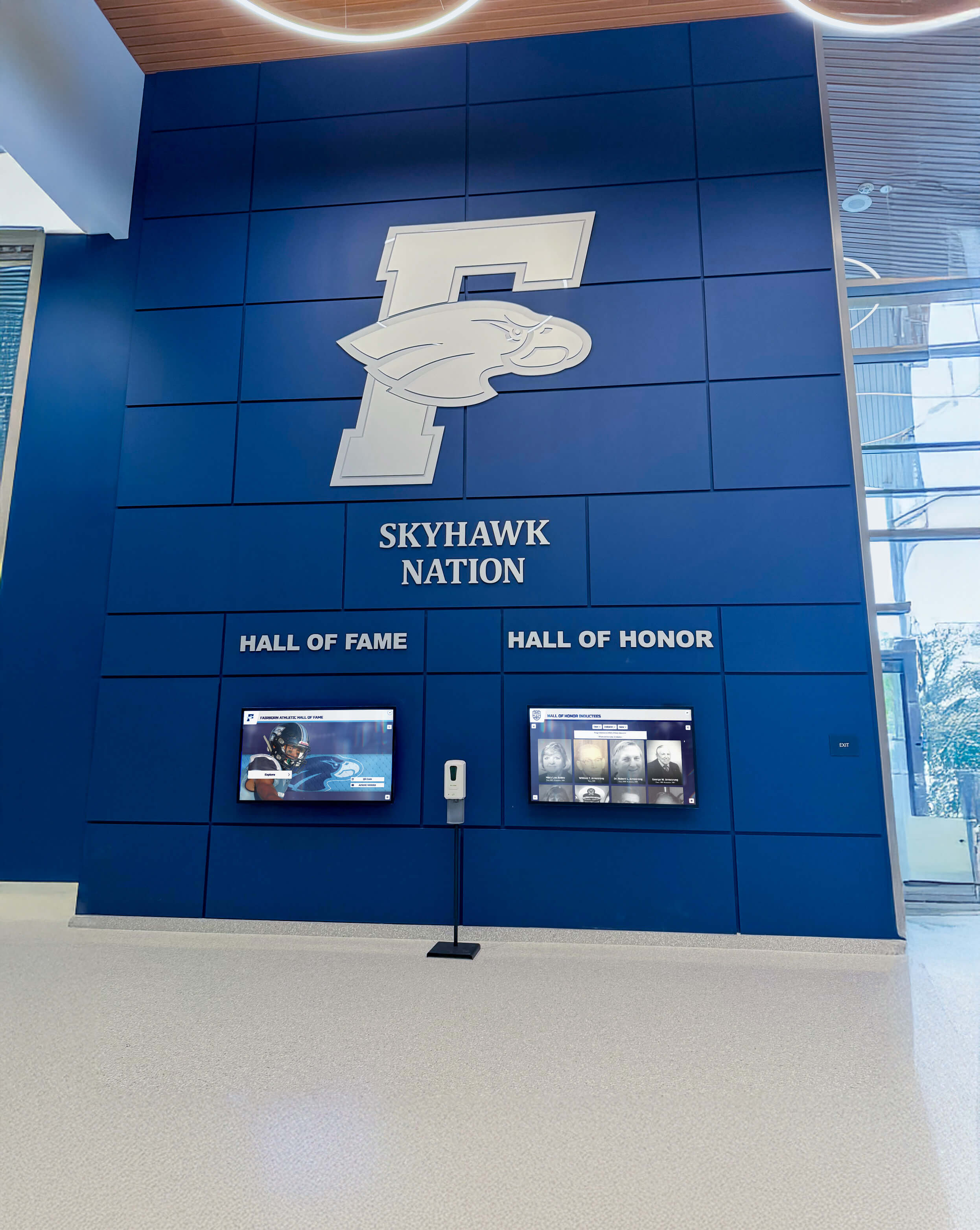Every high school athletic program strives to develop exceptional talent—those rare athletes who transcend typical varsity performance to become genuine college prospects and elite competitors. These top recruits represent the pinnacle of your program’s development capabilities, athletes who attract college scout attention, generate recruiting buzz, and inspire younger teammates to pursue excellence. Yet many schools struggle to effectively showcase this elite talent in ways that maximize recruitment opportunities, build program prestige, and create lasting inspiration throughout their athletic communities.
Top recruit recognition has emerged as a strategic priority for schools committed to supporting exceptional athletes while strengthening overall program reputation. When implemented effectively, recognition systems serve multiple vital functions—they provide college scouts with comprehensive athlete information, demonstrate program quality to prospective students and families, motivate current athletes to pursue elite development, and create lasting records of athletic excellence that build institutional pride across generations.
Understanding Top Recruit Recognition
Top recruit recognition specifically celebrates and showcases athletes who have achieved elite performance levels that distinguish them as serious college prospects. These recognition systems go beyond generic athletic achievement displays to focus strategically on athletes most likely to continue their careers at collegiate levels. By highlighting recruiting rankings, college interest, elite performance metrics, and scholarship potential, schools create powerful tools that support both individual athlete success and broader program development goals.
This comprehensive guide explores every aspect of implementing effective top recruit recognition—from identifying elite talent and developing compelling content to selecting appropriate technology platforms and measuring program impact. Whether you’re an athletic director seeking to elevate program prestige, a coach working to maximize recruitment opportunities for exceptional athletes, or an administrator looking to invest strategically in athletic recognition, this guide provides practical strategies for creating recognition systems that deliver measurable results.
What Defines a “Top Recruit” in High School Athletics
Before implementing recognition programs, schools must clearly define which athletes qualify as top recruits worthy of featured recognition beyond standard athletic acknowledgment.
Performance Thresholds and Achievement Levels
Top recruits typically demonstrate exceptional performance that distinguishes them significantly from typical varsity athletes. Common indicators include holding or approaching school records in their sports, earning all-conference honors at the highest competitive levels, receiving all-state recognition from official state athletic associations, competing successfully at regional or national championship levels, and demonstrating statistical achievements that rank among historical program bests.
These performance thresholds provide objective evidence that athletes have reached elite levels within their competitive contexts, not just excelling relative to current teammates but achieving historically significant results that suggest genuine college-level capability.
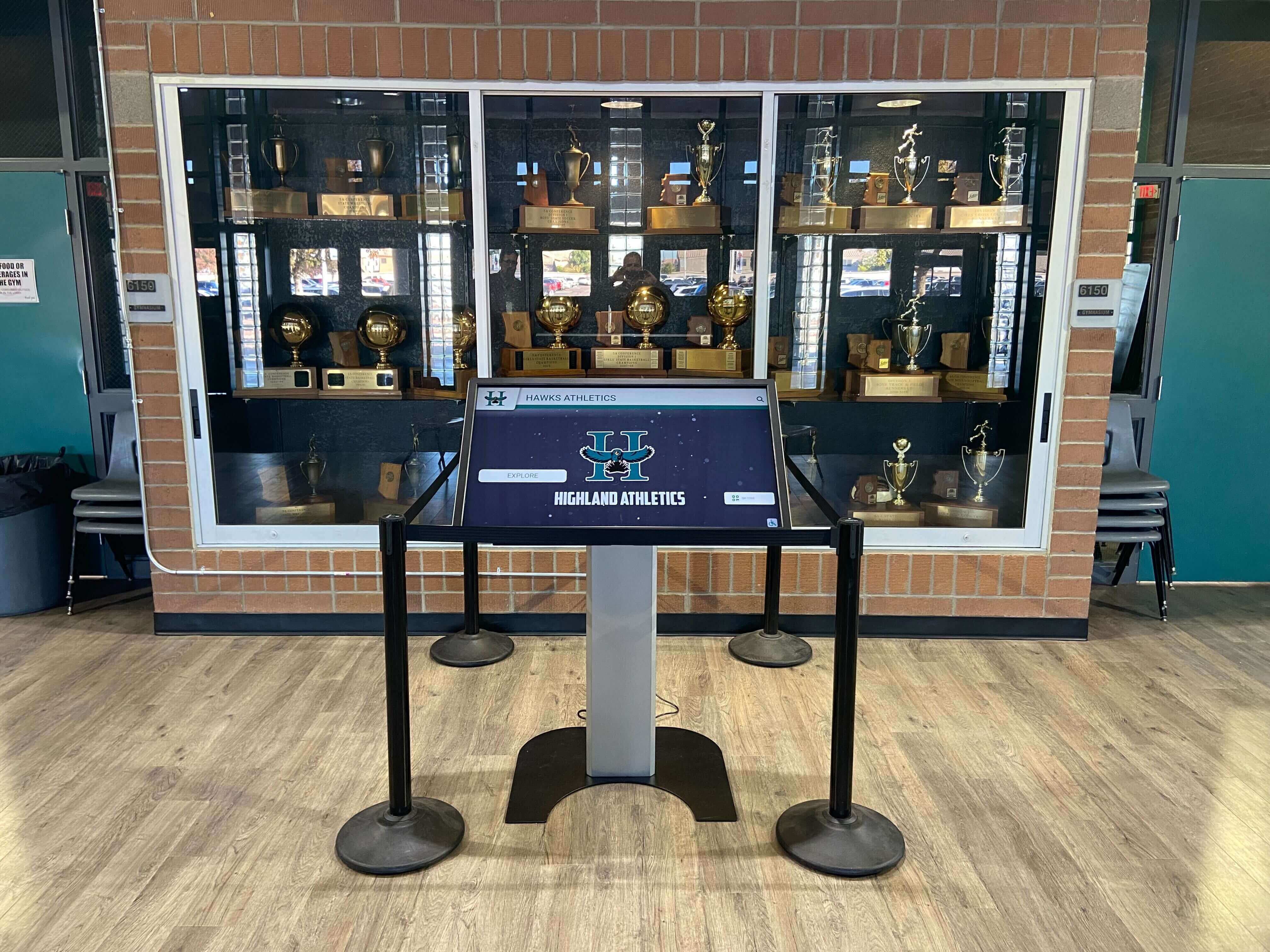
College Recruiting Interest and Activity
Perhaps the most direct indicator of top recruit status is measurable college recruitment interest. This includes receiving scholarship offers from NCAA Division I or II programs, attracting recruiting attention from multiple college programs across various competitive levels, participating in elite recruiting events, showcases, or camps, earning recruiting rankings from recognized services, and conducting official or unofficial visits to college programs.
When multiple college programs actively recruit an athlete, it validates their elite status regardless of whether they ultimately accept scholarship offers. The recruiting process itself demonstrates that objective external evaluators—college coaches—recognize exceptional talent worthy of significant investment.
Multi-Dimensional Excellence Beyond Statistics
While statistics and recruiting attention provide important indicators, top recruits often demonstrate additional qualities including exceptional athletic testing results in strength, speed, or sport-specific measurements, strong academic performance indicating college readiness beyond athletics, leadership capabilities that influence team culture and performance, character traits that college programs value in potential team members, and development trajectory showing continued improvement and untapped potential.
These multi-dimensional qualities help coaches and scouts project how athletes might perform when competing against higher-level competition in college environments. Recognition programs should capture these complete athlete profiles rather than reducing elite athletes to simple statistical summaries.
Strategic Benefits of Top Recruit Recognition Programs
Schools implementing dedicated top recruit recognition realize multiple strategic advantages that extend well beyond simply honoring exceptional athletes.
Enhanced College Recruitment Support
The primary benefit for individual athletes is enhanced recruitment support through comprehensive visibility. Top recruit recognition systems provide college scouts with easily accessible, detailed athlete information including comprehensive statistics and performance data, high-quality video highlights showcasing skills and abilities, academic information demonstrating college readiness, contact information for athletes and coaches facilitating communication, and context about program quality and development capabilities.
When college coaches visit your facilities for competitions, comprehensive recognition displays function as always-available recruiting presentations that work 24/7 regardless of whether coaches are present to provide verbal promotion. Solutions like athletic recruiting recognition displays create professional showcases that significantly enhance scout engagement and information access.
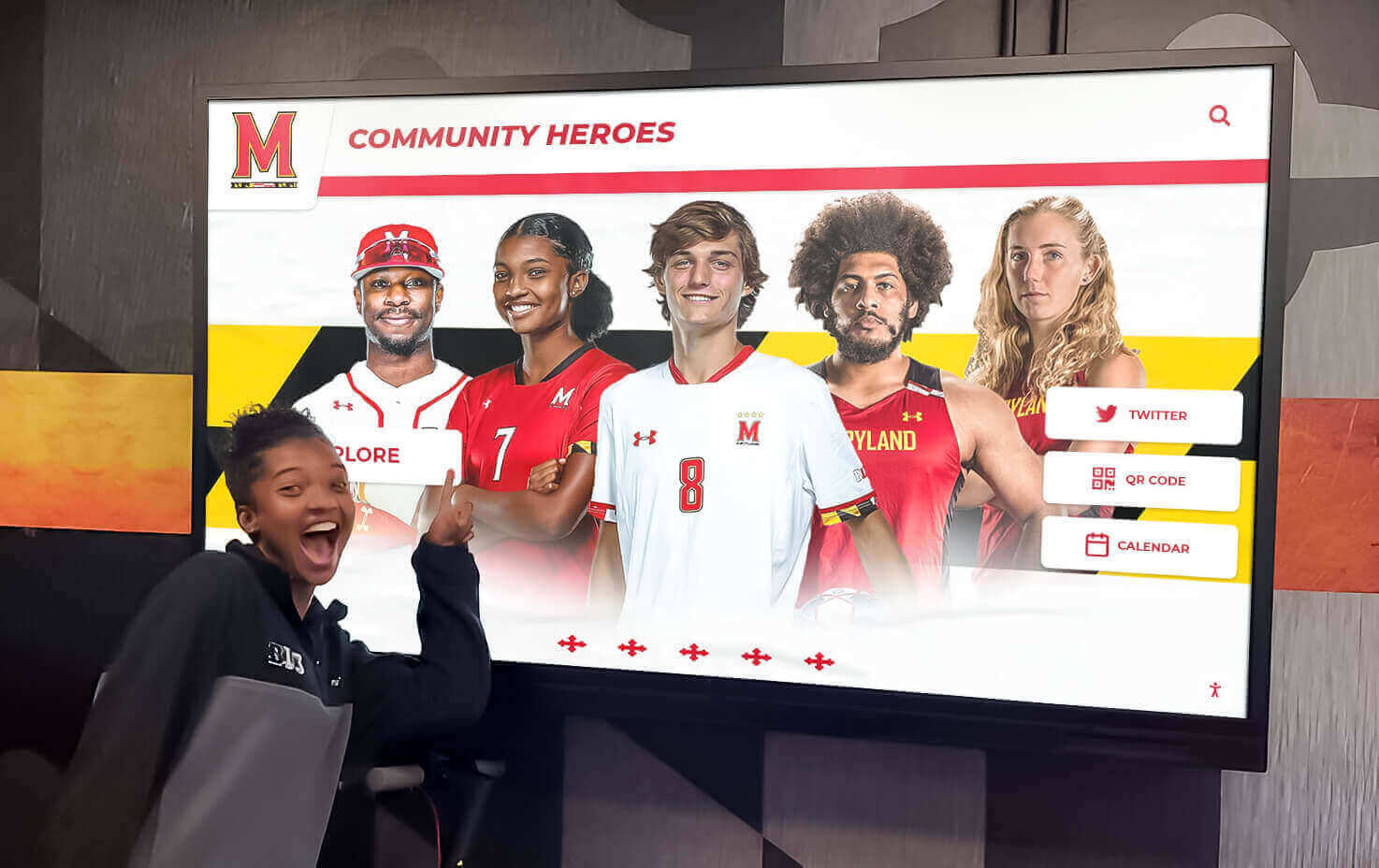
Program Prestige and Competitive Positioning
Top recruit recognition builds overall program prestige that creates compound advantages over time. When prospective athletes and families research schools, visible evidence of elite athlete development significantly influences enrollment decisions. Talented eighth graders choosing high schools look for programs that consistently produce college-level athletes, viewing these schools as optimal environments for their own development aspirations.
This reputation effect creates virtuous cycles where program prestige attracts talented athletes, who then develop into elite recruits themselves, further strengthening program reputation. Over time, programs can transform from typical high school athletics into recognized regional or even national development destinations for serious college prospects.
Motivation and Goal-Setting for Current Athletes
Perhaps equally important as direct recruitment support is the motivational impact on current underclassmen throughout athletic programs. When younger athletes see seniors they know personally earning college scholarships and recruiting attention, abstract aspirations transform into tangible, achievable goals.
Visible top recruit recognition creates constant reminders that elite achievement is possible for those who dedicate themselves appropriately. Research on the psychology of athletic recognition and performance demonstrates that prominent achievement displays significantly increase goal-setting behaviors, training commitment, and performance standards among younger program members who aspire to similar recognition.
Community Engagement and Support Building
Top recruit recognition generates community pride and support that extends beyond athletics. Parents and community members take genuine pride in local athletes achieving exceptional success, often translating this pride into tangible support through boosters, volunteers, facility improvements, and advocacy with school administration.
Media coverage of elite athletes brings positive attention to entire schools and communities, creating goodwill and engagement that benefits many programs beyond athletics. Schools effectively leverage this community interest to build comprehensive support for all students when athletic excellence serves as a visible entry point for broader engagement.
Identifying and Evaluating Top Recruits in Your Programs
Systematic identification processes ensure recognition programs capture all deserving athletes while maintaining credible standards that preserve program prestige.
Objective Performance Criteria
Establish clear performance thresholds that minimize subjective judgment. Sport-specific criteria might include times, distances, or performance metrics that rank within state or regional top percentiles, statistical achievements that compare favorably to historical school or conference records, championship results at appropriate competitive levels, and all-conference or all-state recognition from official athletic associations.
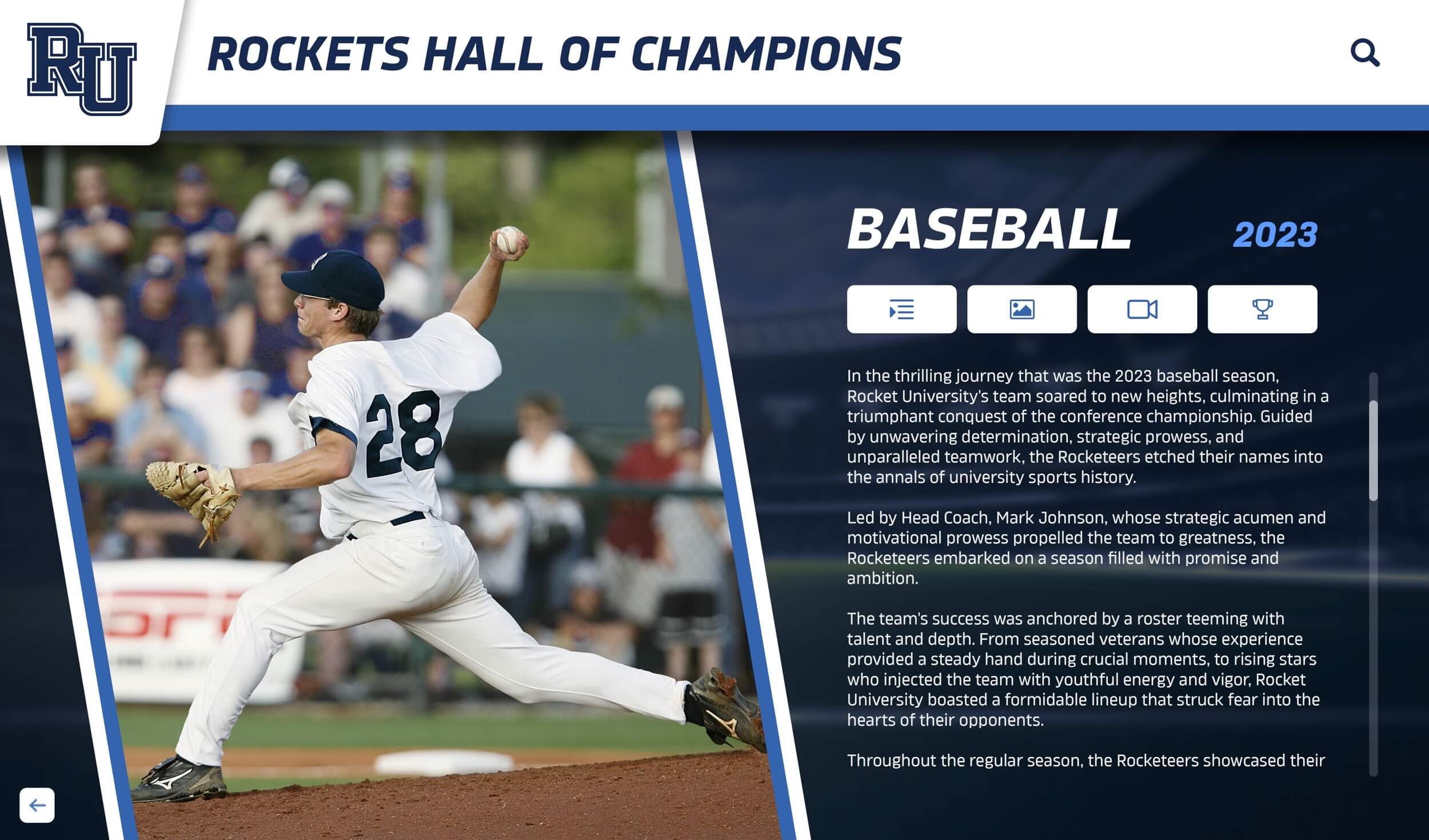
Document these criteria explicitly and apply them consistently across all sports. Transparency prevents perceptions of favoritism while ensuring that deserving athletes across all programs receive appropriate recognition regardless of sport popularity or visibility.
College Recruiting Verification
For criteria based on college interest, establish verification standards. Scholarship offers should be verified through official offer letters or direct coach confirmation rather than athlete or family claims alone. Recruiting rankings must come from recognized services rather than obscure sources with questionable credibility. Showcase participation should be verified through registration or attendance confirmation.
These verification standards maintain program credibility and prevent awkward situations where claimed achievements cannot be substantiated if questioned by skeptical community members or competing programs.
Coach Nomination and Input Processes
While objective criteria provide important foundations, experienced coaches often recognize elite potential that statistics alone might not fully capture. Implement nomination processes allowing coaches to recommend athletes for top recruit recognition with detailed justifications explaining why athletes merit inclusion despite potentially not meeting standard thresholds.
Selection committees can then evaluate these nominations using broader judgment, considering factors like developmental trajectory, injury situations that affected statistics, or exceptional performance in limited opportunities. This flexibility prevents overly rigid criteria from excluding genuinely elite athletes whose circumstances created statistical gaps.
Regular Review and Updates
Top recruit status often emerges over time rather than appearing suddenly. Implement regular review cycles—perhaps quarterly during competitive seasons—that assess whether athletes have crossed recognition thresholds based on recent performances or recruiting developments.
This ongoing evaluation ensures timely recognition when athletes earn top recruit status mid-season or between school years, maximizing both motivation impact and recruitment support during critical periods when college coaches are actively evaluating prospects.
Content Development for Elite Athlete Showcases
Compelling content distinguishes exceptional top recruit recognition from generic athletic displays, creating comprehensive athlete profiles that serve recruitment and inspiration functions effectively.
Comprehensive Statistical Profiles
Top recruit profiles should include complete statistical documentation that provides objective performance evidence. Essential elements include career statistics across all high school seasons showing development progression, single-season bests highlighting peak performances, comparative statistics contextualizing achievements against school and conference records, and relevant athletic testing results such as combine measurements or timed trials.
Present statistics in formats that college coaches recognize and value for specific sports. Football profiles might emphasize 40-yard dash times and shuttle drills, while track profiles focus on official times and qualifying standards. Sport-appropriate presentation demonstrates understanding of what actually matters for college recruitment in each discipline.

High-Quality Video Highlight Integration
For top recruits, video content is often more valuable than any other profile element. College coaches want to see athletes compete, not just read about their statistics. Comprehensive video libraries should include game highlight packages showing best performances in competitive situations, skills demonstrations isolating specific techniques college coaches evaluate, practice footage showing work ethic and coachability, and interview content where athletes discuss their development, goals, and interest in college opportunities.
Video quality matters significantly—grainy, distant footage with poor angles provides limited value compared to clear, well-framed video that allows coaches to genuinely evaluate athletic capabilities and competitive performance. Schools should invest in quality video capture equipment and editing capabilities specifically for recruitment purposes.
Recruiting Profile Information
Facilitate college recruitment by including practical information coaches need. Profiles should provide athlete contact information including email and phone numbers, coach contact information for direct inquiries, academic credentials including GPA, class rank, and standardized test scores, physical measurements relevant to the sport such as height, weight, wingspan, and position specifics, and available competition schedules allowing college coaches to plan recruiting visits.
This comprehensive information transforms recognition displays into functional recruiting tools rather than simply celebratory content, providing genuine value that justifies coach and scout engagement with displays during facility visits.
Personal Narratives and Development Stories
Beyond statistics and recruiting facts, include narrative content that humanizes elite athletes and provides context about their journeys. Effective narratives address how athletes discovered and developed their sport passion, obstacles they overcame during their development, training approaches and commitment levels that enabled their success, influences including coaches, family, or mentors who shaped their development, and goals and aspirations for college athletics and beyond.
These personal dimensions create emotional connections that inspire younger athletes while providing college coaches with character insights that inform recruiting evaluations beyond pure athletic capability assessments.
Technology Platforms for Top Recruit Recognition
The technology infrastructure supporting recognition programs significantly affects functionality, maintenance requirements, and overall impact.
Interactive Touchscreen Display Systems
Modern touchscreen displays provide optimal platforms for comprehensive top recruit recognition. Large-format touchscreens typically 55-75 inches enable detailed content presentation, intuitive touch navigation allows visitors to explore athlete profiles interactively, multimedia support integrates photos, videos, and various content formats seamlessly, and professional appearance conveys program quality and sophistication matching elite athlete accomplishments.
Commercial-grade displays designed for continuous operation in high-traffic environments provide reliability and longevity that consumer displays cannot match. Professional installations should include proper mounting, cable management, and integration with facility aesthetics creating polished presentations worthy of the athletes being honored.

Comprehensive guides to touchscreen kiosk software selection help schools make informed technology decisions that align with specific needs and budgets while ensuring long-term platform viability.
Cloud-Based Content Management Systems
Software platforms managing recognition content should prioritize ease of use and remote accessibility. Essential capabilities include intuitive content management interfaces allowing non-technical staff to update information, cloud-based architecture enabling updates from any location without physical access to displays, multimedia asset management organizing photos, videos, and documents efficiently, and user permissions controlling who can modify different content types.
Advanced features worth considering include automated social sharing enabling visitors to post athlete profiles to personal accounts, analytics tracking which athletes and content generate most engagement, mobile responsiveness allowing content access via smartphones and tablets, and integration capabilities connecting to other school data systems for automated updates.
Purpose-built recognition platforms designed specifically for educational environments, such as those provided by Rocket Alumni Solutions, offer school-optimized interfaces and workflows that generic digital signage systems cannot match without extensive customization.
Web-Based Companion Platforms
While physical displays in facilities provide primary recognition, web-based companion platforms extend reach significantly. Online athlete databases accessible via school websites allow college coaches to research athletes remotely without requiring campus visits, enable recruits to share their profiles with coaches via direct links, provide family and community members access to recognition content from anywhere, and create permanent records preserving athlete achievements indefinitely beyond high school careers.
This omnichannel approach maximizes recognition impact by ensuring elite athlete information is accessible wherever college coaches prefer to conduct research—whether during facility visits or remote evaluation from their offices.
Mobile Applications and Responsive Design
Increasingly, college coaches and scouts research prospects via smartphones during games, practices, or downtime between recruiting activities. Recognition platforms should provide excellent mobile experiences through responsive web design that adapts content to various screen sizes, native mobile applications offering optimized interfaces for phones and tablets, and offline capability allowing content access without reliable internet connectivity.
Mobile accessibility dramatically expands when and where college coaches can engage with top recruit information, removing barriers that might otherwise prevent adequate consideration of athletes from schools using less accessible recognition approaches.
Strategic Display Placement and Implementation
Physical location and implementation quality significantly impact recognition program effectiveness and perceived value.
High-Visibility Location Selection
Top recruit displays should occupy premier locations within athletic facilities. Optimal placement includes main entrance lobbies where all facility visitors pass, hallways connecting locker rooms to competition venues where athletes and families regularly transit, athletic director and coaching offices where college scout visits typically begin, and hospitality areas where visiting teams and coaches spend time before competitions.
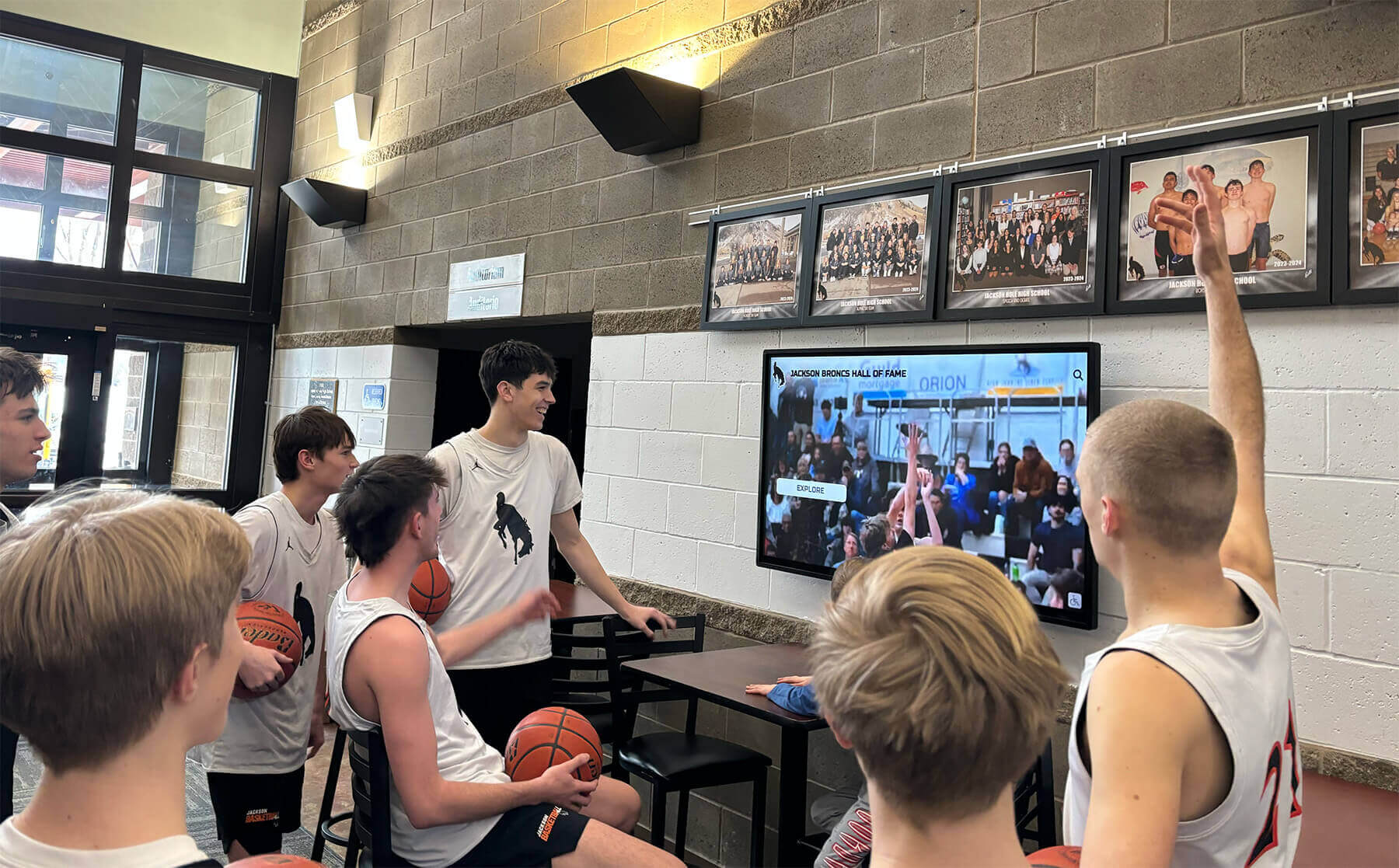
High-visibility locations ensure maximum exposure to target audiences including college coaches and scouts, prospective athletes and families evaluating your program, current athletes who benefit from inspiration and motivation, and community members whose support strengthens overall programs.
Avoid relegating recognition displays to low-traffic areas where investment cannot generate appropriate return through engagement and awareness.
Professional Installation and Presentation Quality
Installation quality directly affects how seriously college coaches and other audiences take recognition content. Professional installations should include secure, appropriate mounting hardware protecting valuable equipment, clean cable management concealing power and networking infrastructure, proper lighting ensuring visibility without glare or reflection issues, and aesthetic integration with surrounding facility design and branding.
Poor installation quality undermines recognition program credibility regardless of content quality. College coaches evaluating program professionalism note these details, consciously or subconsciously incorporating facility quality and attention to detail into their overall program assessments.
Multi-Location Strategies for Large Facilities
Schools with multiple athletic facilities or large complexes might implement multi-display strategies ensuring recognition reaches all relevant audiences. Consider placing displays at multiple venues including main competition gymnasiums, auxiliary practice facilities, stadium concourses, aquatic centers, and field houses.
Synchronized content management platforms allow consistent information across multiple displays while potentially featuring sport-specific content at relevant locations. Basketball recruits might see prominent basketball focus at gymnasium displays while still having access to comprehensive multi-sport content.
Integration with Other Recognition Programs
Top recruit recognition works most effectively as one component of comprehensive athletic recognition rather than isolated content. Consider integrating with championship banners and team recognition celebrating collective success, general athletic achievement displays honoring broader participation, academic recognition highlighting scholar-athletes and educational excellence, and alumni success stories connecting current recruits to program history.
This integration positions elite athlete recognition within broader contexts that communicate comprehensive program quality and values beyond simply producing college prospects.
Maintaining and Updating Top Recruit Recognition
Ongoing management ensures recognition programs remain current, relevant, and valuable rather than becoming outdated displays that undermine rather than enhance program credibility.
Real-Time Updates During Recruiting Cycles
Top recruit status evolves throughout recruiting processes as athletes receive offers, commit to colleges, and achieve new performance milestones. Implement systems enabling rapid content updates including adding new scholarship offers as athletes receive them, updating recruiting rankings as services publish new evaluations, incorporating recent performance achievements during competitive seasons, and celebrating college commitments as decisions are made.
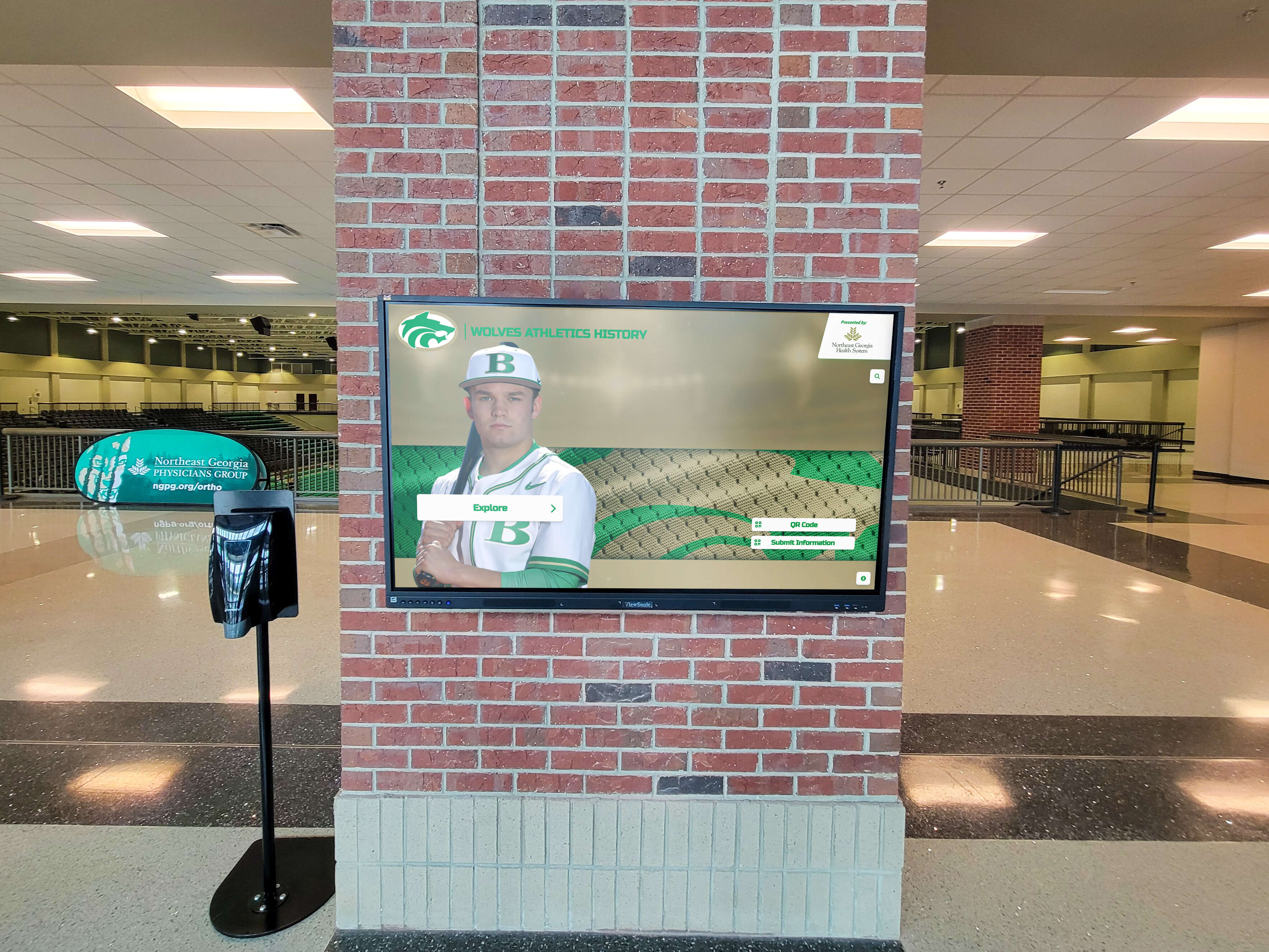
Real-time updates maintain content accuracy while maximizing motivational impact when achievements occur and community interest peaks. Cloud-based management platforms make these updates straightforward without requiring physical access to displays or technical expertise for content modifications.
Post-High School Career Tracking
Consider extending recognition to track how top recruits perform at collegiate levels. Updates might include freshman season highlights and statistics, championship achievements at college levels, individual honors and awards earned in college competition, professional opportunities for exceptional college performers, and post-athletic career success in various fields.
This long-term tracking demonstrates genuine investment in athlete success beyond how they benefit high school programs, strengthening relationships with alumni while providing current athletes with inspiring examples of what college pathways can enable. Comprehensive alumni engagement through digital recognition creates lasting connections that benefit both individuals and institutions.
Regular Content Audits and Quality Improvements
Schedule periodic content reviews ensuring profile quality remains high and information stays accurate. Audits should verify that all statistics and achievements are current and correct, photos meet quality standards and appropriately represent athletes, video content plays correctly and provides genuine recruitment value, contact information remains accurate as athletes graduate and transitions occur, and overall presentation aligns with current program branding and standards.
These quality audits prevent recognition programs from degrading over time as initial content becomes outdated or as accumulated quick updates create inconsistent presentation quality across different athlete profiles.
Technology Maintenance and Upgrades
Hardware and software require ongoing maintenance ensuring reliable operation. Establish protocols for cleaning displays and maintaining physical condition, updating software with security patches and new features, monitoring system performance and addressing technical issues promptly, refreshing hardware as equipment ages or newer capabilities emerge, and maintaining network connectivity and adequate bandwidth.
Most commercial-grade displays operate reliably for 5-10 years with appropriate maintenance, but planning for eventual technology refresh prevents recognition systems from becoming outdated technology liabilities rather than modern program assets.
Promoting Top Recruit Recognition Programs
Creating excellent recognition content represents only part of success—strategic promotion drives the awareness and engagement that makes recognition truly impactful.
Launch Events and Awareness Campaigns
When implementing new top recruit recognition programs, invest in comprehensive promotional campaigns building awareness. Strategies include formal unveiling events during high-profile athletic occasions like playoff games or championship celebrations, featured announcements in school communications including newsletters, social media, and website features, media outreach generating news coverage for the recognition program itself, and direct invitations to recognized athletes and families encouraging them to view their profiles.

Launch promotion establishes recognition programs as significant school initiatives worthy of attention rather than minor additions that community members might easily overlook.
Integration with Recruiting Events and Showcases
Leverage recognition displays during recruiting-focused events. When hosting recruiting camps, showcases, or tournaments, feature displays prominently in registration areas or central locations, encourage attending athletes to explore top recruit profiles and program history, highlight local athletes on displays demonstrating program development capabilities, and provide information about recognition program criteria inspiring visiting athletes to pursue similar achievement.
These event integrations ensure maximum exposure to precisely the audiences—prospective elite athletes and their families—most likely to be influenced by top recruit recognition when making enrollment and program selection decisions.
Social Media Amplification Strategies
Coordinate recognition displays with social media presence amplifying reach beyond those who physically visit facilities. When adding new top recruits or updating existing profiles, create complementary social media content including compelling photos from profiles driving interest in full displays, video clips or highlights showcasing athlete capabilities, athlete quotes and stories providing personal perspectives, and links to web-based profile versions allowing detailed exploration.
Tag college programs recruiting athletes, encouraging broader visibility and engagement beyond your immediate community. This multi-channel approach ensures recognition content reaches wide audiences while driving physical visitation to displays for those who can visit campus.
Involving Top Recruits in Promotion
Recognized athletes themselves often provide the most authentic and effective promotion. Encourage them to share their recognition profiles via personal social media, participate in promotional events like display unveilings or media interviews, mentor younger athletes aspiring to similar recognition, and provide testimonials about how recognition impacted their recruiting experiences.
Athlete voices carry unique credibility with peers and younger athletes considering whether to dedicate themselves to pursuing elite athletic development and college opportunities.
Measuring Recognition Program Impact and ROI
Systematic evaluation demonstrates recognition program value while informing continuous improvement and optimization efforts.
College Recruitment Outcome Tracking
The most direct success measure is recruitment outcomes for recognized athletes. Track metrics including scholarship offer rates for top recruits, college commitment rates and competitive levels of chosen programs, recruiting timeline efficiency from initial identification to college commitment, college coach engagement frequency during facility visits, and recruiting ranking changes correlating with recognition program implementation.
While many factors influence individual recruitment outcomes, aggregate patterns often reveal program-level impacts. Increasing scholarship offers, higher-level college placements, or accelerated recruiting timelines following recognition program implementation suggest meaningful positive effects.

Athlete and Family Satisfaction Assessment
Direct stakeholder feedback provides valuable qualitative insights. Gather input through athlete and family surveys about recognition program value and usefulness, exit interviews with graduating athletes about how recognition impacted their experiences, testimonials from recruited athletes about recognition program contributions to their college opportunities, and coach feedback about recruiting support effectiveness.
This qualitative data often reveals specific program aspects that work particularly well or areas needing improvement that quantitative metrics might not identify.
Program Reputation and Enrollment Impact
Broader institutional effects may emerge over time as recognition programs build program prestige. Monitor indicators including athletic program enrollment trends, particularly for talented incoming freshmen, reputation perception in coach networks and recruiting circles, media coverage quality and quantity for athletic programs and achievements, and community engagement levels including booster participation and financial support.
These longer-term institutional impacts, while harder to attribute solely to recognition programs, often represent the most significant value creation as program prestige generates compounding benefits across multiple dimensions.
Technology Platform Analytics
Digital recognition systems provide detailed usage data revealing engagement patterns. Valuable metrics include total visitor interactions and session frequencies, average engagement duration showing how long visitors explore content, most-viewed athlete profiles indicating compelling content, search patterns revealing how visitors explore recognition information, and peak usage times identifying optimal periods for content updates or promotion.
This analytics data informs content development priorities and helps optimize recognition programs based on actual user behavior rather than assumptions about how audiences might engage with content.
Addressing Common Implementation Challenges
Schools implementing top recruit recognition typically encounter predictable obstacles with straightforward solutions.
Budget Constraints and Funding Solutions
Digital recognition systems require financial investment that may challenge athletic budgets. Practical approaches include phased implementation starting with software before adding physical hardware, pursuing dedicated funding from booster clubs or parent athletic organizations, seeking local business sponsorships where companies receive recognition in display content, applying for educational technology or athletic development grants, and developing multi-sport cost-sharing arrangements distributing expenses equitably.
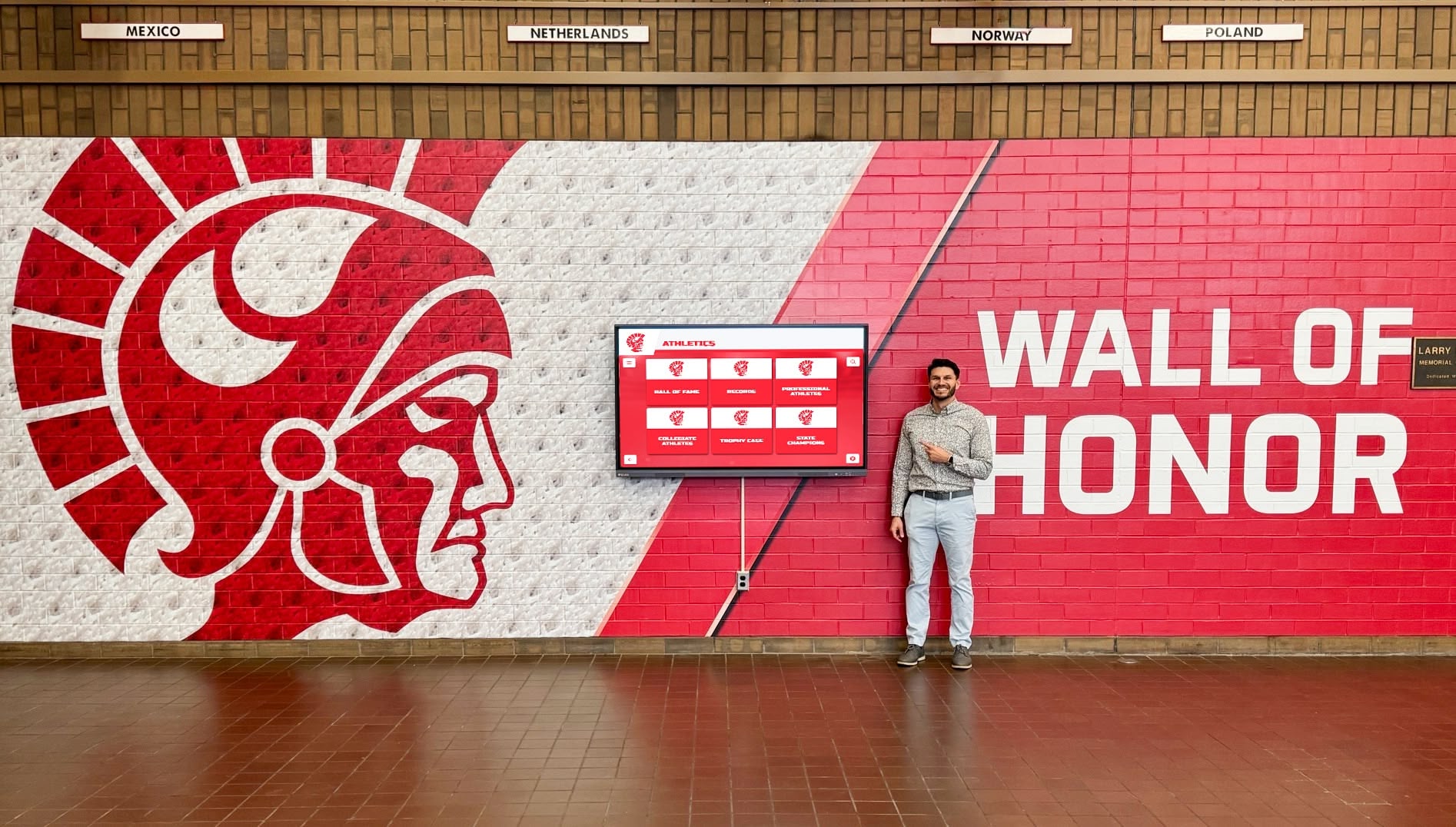
Many schools successfully frame recognition programs as recruitment tools when approaching potential funders. Donors supporting athletics often respond enthusiastically to investments that directly help athletes achieve college opportunities and scholarships representing significant financial value.
Content Development Capacity and Expertise
Creating high-quality athlete profiles requires time and skills schools may lack. Solutions include engaging student journalism or media production classes in content development, recruiting parent volunteers with photography or video production experience, partnering with local media professionals seeking community involvement opportunities, utilizing content development services from recognition platform providers, and starting with simpler profiles and enhancing gradually as capacity develops.
Comprehensive content strategy guides for digital recognition provide frameworks helping schools develop sustainable content creation approaches aligned with available resources.
Criteria Objectivity and Fairness Concerns
Establishing fair, objective recognition criteria can prove challenging, particularly when subjective elements like “recruiting interest” vary significantly across sports. Address concerns through transparent, well-documented criteria applied consistently across all programs, diverse selection committees representing multiple sports and perspectives, clear appeal processes allowing coaches to advocate for deserving athletes, and regular criteria reviews ensuring standards remain appropriate as programs evolve.
Transparency and consistency build credibility and acceptance even when specific decisions occasionally generate disagreement or debate within school communities.
Technology Expertise and Ongoing Management
Not all schools employ staff with extensive technology experience for managing digital systems. Solutions include selecting platforms specifically designed for non-technical users with intuitive interfaces, partnering with vendors providing comprehensive training and ongoing support, engaging tech-savvy parents or alumni as volunteers when appropriate, starting with basic features before adopting advanced capabilities, and documenting procedures thoroughly so knowledge doesn’t depend on specific individuals.
Modern recognition platforms increasingly prioritize user-friendly design making technology barriers minimal even for schools with limited technical infrastructure or expertise.
Future Trends in Elite Athlete Recognition
Recognition technology and approaches continue evolving, creating new opportunities for supporting top recruits and enhancing program prestige.
Artificial Intelligence and Automated Content
Emerging AI capabilities may soon enable automated highlight generation from game footage using intelligent clip selection, natural language profile generation based on statistical inputs and achievement data, personalized content recommendations based on visitor interests and behaviors, predictive analytics identifying athletes likely to achieve top recruit status early in development, and intelligent search allowing conversational queries rather than menu-based navigation.
These capabilities could dramatically reduce manual effort required for content development while potentially improving profile quality and relevance through data-driven approaches.
Enhanced Video and Multimedia Integration
Future platforms will likely feature native video editing allowing profile creators to trim and combine clips directly within recognition systems, 360-degree video providing immersive perspectives on athletic performance, drone footage offering unique viewing angles for outdoor sports, virtual reality experiences recreating significant performances or achievements, and augmented reality overlays adding contextual information to physical spaces.
These advanced multimedia capabilities create increasingly engaging and informative recognition experiences that more effectively communicate athletic excellence to college coaches and other audiences.
Social Integration and Community Features
Upcoming systems may offer seamless social platform connections for one-touch profile sharing, collaborative features allowing teammates and coaches to contribute to athlete profiles, video messaging capabilities connecting current recruits with college athletes or alumni, crowd-sourced content where fans can submit photos or videos for consideration, and networking tools facilitating mentorship relationships between generations of athletes.
This participatory approach transforms recognition from institutional broadcast into dynamic community conversations engaging broader audiences more deeply.

Data Integration and Performance Analytics
Advanced platforms may eventually connect directly with performance tracking systems for automated statistical updates, wearable device data showing training volumes and intensity levels, academic information systems for automated grade and honor integration, recruiting platform connections showing verified offer and interest data, and comparative analytics contextualizing athlete achievements against state or national databases.
This integration eliminates manual data entry while ensuring constantly updated, accurate information across all recognition content.
Integration with Comprehensive Athletic Programs
Top recruit recognition delivers maximum value when integrated strategically with broader athletic program initiatives rather than functioning as isolated displays.
Connection to Athletic Development Pathways
Help younger athletes understand pathways to top recruit status by connecting recognition displays to youth development programs showing progression from middle school through varsity, strength and conditioning program information explaining physical development approaches, skill development resources identifying training methodologies elite athletes utilized, and mentorship programs connecting current athletes with recognized top recruits.
This integration transforms recognition from simple celebration into functional development roadmaps that guide aspiring athletes toward similar achievement. Comprehensive guides to student athletic recognition programs provide frameworks for multi-level recognition supporting athlete development at all stages.
Academic Excellence Integration
College recruitment depends heavily on academic qualification in addition to athletic ability. Integrate academic recognition by prominently featuring GPA and academic honors alongside athletic achievements, celebrating academic All-Conference and All-State recognition equivalently to athletic honors, highlighting college admission test scores demonstrating college readiness, and featuring intended majors and academic interests showing well-rounded student-athletes.
This integration communicates that your programs develop complete student-athletes ready for college success in classrooms as well as competition, strengthening college coach confidence in recruiting from your programs.
Character and Leadership Development
College programs increasingly prioritize character, leadership, and cultural fit alongside athletic ability. Recognition programs should address community service involvement and impact, peer mentoring and youth coaching activities, team captain and leadership roles, character awards and recognition from various sources, and contributions to team culture beyond individual statistics.
This well-rounded recognition positions athletes as outstanding citizens who will represent college programs positively in all contexts, not just athletes focused exclusively on personal performance statistics.

Alumni Network Connections
As recognized top recruits graduate and continue careers at collegiate levels, maintain connections through ongoing profile updates with college achievement information, alumni mentorship programs connecting current recruits with recent graduates, alumni panels at recruiting events sharing experiences and advice, and fundraising engagement where successful alumni support programs that developed them.
These lasting connections create alumni networks that become valuable resources for both current athletes navigating recruitment and institutions building comprehensive support systems. Research on effective alumni engagement strategies demonstrates how recognition programs become powerful relationship-building tools extending far beyond high school years.
Conclusion: Strategic Investment in Athletic Excellence
Top recruit recognition represents far more than simple celebration of exceptional athletic achievement. When implemented strategically, recognition programs become powerful tools that support individual athlete recruitment while building comprehensive program prestige, inspiring current athletes throughout all teams, engaging communities and generating support, and creating lasting institutional records preserving excellence across generations.
The most effective programs view top recruit recognition as strategic infrastructure investment rather than decorative enhancement. These systems actively support athletic program missions by helping exceptional athletes maximize college opportunities through enhanced visibility and professional presentation, attracting talented incoming athletes through demonstrated development capabilities, building program reputations that generate compounding advantages over time, and creating cultures of excellence where elite achievement becomes expected rather than exceptional.
Modern digital recognition platforms make sophisticated implementation accessible for schools across all sizes and resource levels. Cloud-based content management, professional display hardware, multimedia integration capabilities, and intuitive user interfaces transform what once required extensive technical expertise into manageable programs that typical athletic staff can implement and maintain effectively.
For schools committed to athletic excellence and supporting exceptional student-athletes in pursuing college opportunities, top recruit recognition delivers measurable return on investment while honoring the dedication and achievement of individuals who represent the pinnacle of your program development capabilities.
Ready to transform how your school recognizes and supports elite athletic talent? Discover how comprehensive digital recognition solutions like those offered through Rocket Alumni Solutions can create engaging displays that showcase your top recruits professionally while building program pride and inspiring excellence. Explore proven approaches to showcasing college commitments and learn how digital recognition supports college recruitment for elite athletes pursuing their dreams.
